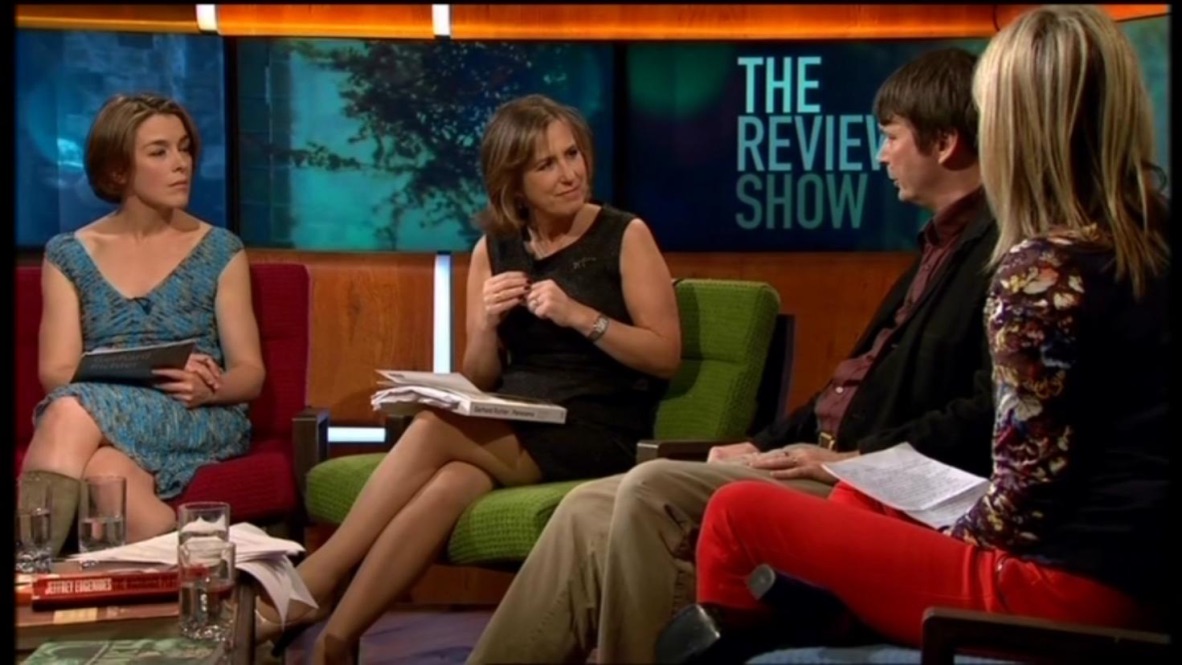In an earlier post about tennis on TV I wrote about how the sport, when televised live, is adulterated in order to shore up incomplete narratives. The adding of narrative filler is but one aspect of a pervasive mode of interference associated with the live editing of broadcast material. A subtler form of intervention, designed to diminish narratives that are complete but too revealing, is to be found in television programmes that feature presenter-led interviews. So modest are the adjustments wrought in this territory that, if noticed at all, they may be written off as insignificant. They are, however, aspects of a concealed system that, like the fantasticated Deep Web and its fearsome contents, is hard to uncover. This is not because the portal to the territory has been cunningly rendered invisible to search engines but because it is located beneath our noses.
The phenomenon that defines this shadowy realm can be called the Performance of Unperformance. In itself it is not a new phenomenon but one that has acquired a pervasive presence – a veritable Japanese Knotweed of deportment – its behaviours gradually overwhelming the flora of native conduct. It is readily researched and will be found thriving on a television near you.
Outside the realm of the actual actor employed in dramas there are individuals who come under daily scrutiny and of whom the highest standards of presentation are expected. The current affairs programme presenter must not only operate within conventional performance criteria but he or she must also regularly deal with interviewees from public life who may not be polished public speakers.

 A similar protocol pertains when a studio visitor, having completed a response to a question, reaches for a glass of water. The vision mixers are invariably impressive – they rarely allow us to see such transgressions for more than a split second before cutting to another shot. A hand is extended, it moves towards a glass then pouf! It’s history. The mixer’s skill preserves the viewer from a sense that what is being viewed is in any way artificial. The viewer, it is assumed, will like to see people who can function without being compromised by nervousness. An inverted system of values is introduced in which to be seen reaching for a glass of water is not understandable but a sign of weakness. It is instructive to compare the team effort required to maintain these studio presentation values to the efforts of a football team, whose every mistake is fully visible and cannot be edited out.
A similar protocol pertains when a studio visitor, having completed a response to a question, reaches for a glass of water. The vision mixers are invariably impressive – they rarely allow us to see such transgressions for more than a split second before cutting to another shot. A hand is extended, it moves towards a glass then pouf! It’s history. The mixer’s skill preserves the viewer from a sense that what is being viewed is in any way artificial. The viewer, it is assumed, will like to see people who can function without being compromised by nervousness. An inverted system of values is introduced in which to be seen reaching for a glass of water is not understandable but a sign of weakness. It is instructive to compare the team effort required to maintain these studio presentation values to the efforts of a football team, whose every mistake is fully visible and cannot be edited out.
The broadcast conventions generate images of individuals who appear to be at ease with performance conventions. They resemble, therefore, thoroughly confident and accomplished beings emptied of any compromising psychology that might have the unintended effect of suggesting that the studio situation is fundamentally untenable, by which I mean the notion that the mode in which they appear to function so well is absolutely not suitable for everyday life. Such beings are admired but there is a risk that they are seen as wholly spontaneous, that is, they do not think, they only utter. They have no interior, no mental process. Their powers of analysis and agility in argument are outwardly directed and focused but function without recourse to private knowledge.
Strictly speaking, it is possible for a presenter (but not an interviewee) to be wholly without knowledge if the director supplies them with a steady stream of information and instruction through a concealed earpiece. It is equally possible, of course, that the presenter is a well briefed professional but even if this is the case, the level of professionalism will be such that a drink of water or a quick scan of the notes can be pulled off while the camera is momentarily directed elsewhere.
Viewers know that people on television are performing but the polish that is consistently constructed around this mode of performance is seductive: it is easy to imagine that people on television are not performing because they perform nonperformance so well. The next logical step is to assume that this is how ordinary people who are not on television should also behave. It may even be assumed that most people do behave in this way and that oneself is the unfortunate exception.
If television viewers do not notice the sanitising activities of the vision mixer, they still, I am sure, experience them subliminally. The interventions fall beneath the threshold of conscious perception but their significance is noted. One effect of this will be to make physical indications of uneasiness seem shameful. While it may be considered simple common sense not to stutter or look panic stricken on live television, the editing out of reflexive behaviour – that which acknowledges the mechanics of the studio setup – is executed not by the presenter but by an invisible, unidentified agent whose activities may seem disapproving and punitive. This can be compared to a hypnotic injunction the content of which the subject internalises then experiences as their own view.
Such is the predatory nature of the point of view shot – it becomes our point of view rather than that of the interviewer, who functions as a (personable, quick thinking) prosthetic extension of our own position – that not only do we imaginatively appropriate the skills of the interviewer but we are also compelled to regard the interviewee as a potential repository of the tics and twitches that we, in our other imagined role as interviewee, must work to suppress.
The experience of watching interviewers and their subjects at work is not quite as exciting as this – the anxious and uncharitable thoughts are moved to the periphery of consciousness as they are when we watch a tightrope walker or lion tamer and ponder on the possibility of their falling off or being eaten alive.
The gaze of the television camera is carefully and skilfully constructed. The edits occur in real time before one’s eyes but they are largely imperceptible. The seamlessness is sufficient to persuade us that what we see is the product of our gaze. If this is the case then it is we, not the servants of the broadcaster, who are continuously modifying what is seen. It is we who are suppressing evidence of psychology and frailty.
Such a state of affairs will contribute to a rigid definition of what constitutes performance and to the elevation of the performer to the level of an opaque, human-like machine rather than a psychologised being. Performance itself comes to be seen as a purified, optimised behaviour that is implicitly disparaging of unpolished, unprepared and hesitant conduct. Performance actually acquires the status of the nonperformed while the latter loses all its connotations of authenticity and becomes the repository of shameful behaviours.
If we subscribe to this notion of widespread subliminal messaging we are within a hair’s breadth of the widely reported delusion of the paranoid schizophrenic that the television is sending him secret, personalised messages that are controlling his behaviour. In addition to the content delivered by the programme itself there is, in the view of the complainant, an extra level of communication which is no less meaningful than the programme. The paranoid schizophrenic, in this model, is not only trying to impose some sense on an elusive internal phenomenon but is picking up on something going on in the real world that he also finds destabilising.
BBC2’s ‘Review Show’ is fertile ground for anxiety spotters because the guests are seated close to each other, often in a crescent, which makes it difficult for the director to isolate speakers without repeatedly going into a tight shot. The guests are not always aware that they are being included when attention appears to be focused on a speaker so they will often stray from the attentive ideal. On this occasion everyone is performing their attention quite well:

 On this occasion the presenter, Kirsty Wark, seems less interested than she would wish to appear and has acquired a glazed expression. Her female guest, however, is being ideally attentive.
On this occasion the presenter, Kirsty Wark, seems less interested than she would wish to appear and has acquired a glazed expression. Her female guest, however, is being ideally attentive.
 Attentiveness is obviously highly desirable. Here Kirsty – a highly experienced presenter – has come up with an excellent version of attentiveness that could almost pass for the real thing. Possibly slightly too intense but pretty good.
Attentiveness is obviously highly desirable. Here Kirsty – a highly experienced presenter – has come up with an excellent version of attentiveness that could almost pass for the real thing. Possibly slightly too intense but pretty good.
The professional presenter, as distinct from the actor of dramas, must perform the unperformed with aplomb. The actor of dramas has, in some respects, an easier job because her objective is transformation – if she gets it wrong it will be seen as an insufficient conversion but if the presenter is seen to perform the unperformed then the shortcoming is a betrayal of the authenticity of the entire programme.
The unperformed of the presenter is not informal – we need it to be unwaveringly focused and efficient and we know that the autocue will often support this effect. Even so, the fantasy, I think, is that despite the fact that we know that it is the presenter’s experience plus the technical support of the team that gives him the requisite polish, we simultaneously believe that he is a being of perfect confidence and self-belief.
 We know it’s artificial but we want to see the subjects denying this, both in the name of professionalism – we appreciate a polished production – and of self improvement, whereby we are able to study and learn from individuals who are being closely observed in real time as they make public presentations. In these studies we can distinguish between the consummate professional – Jeremy Paxman, say, and those interviewees who are not schooled in studio behaviour but are aware of the rules. This isn’t a purely voyeuristic exercise – the TV professionals are an educative presence – they not only teach us what’s going on in the world, if they happen to work in current affairs, but they also show us the minute details of artificial composure, the moment by moment maintenance of a fluid, attentive, integrated surface. They demonstrate that you can go a long way with an edited, smoothed, heightened, repurposed version of what is normally regarded as your self.
We know it’s artificial but we want to see the subjects denying this, both in the name of professionalism – we appreciate a polished production – and of self improvement, whereby we are able to study and learn from individuals who are being closely observed in real time as they make public presentations. In these studies we can distinguish between the consummate professional – Jeremy Paxman, say, and those interviewees who are not schooled in studio behaviour but are aware of the rules. This isn’t a purely voyeuristic exercise – the TV professionals are an educative presence – they not only teach us what’s going on in the world, if they happen to work in current affairs, but they also show us the minute details of artificial composure, the moment by moment maintenance of a fluid, attentive, integrated surface. They demonstrate that you can go a long way with an edited, smoothed, heightened, repurposed version of what is normally regarded as your self.
03.07.2014

